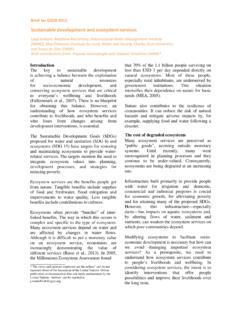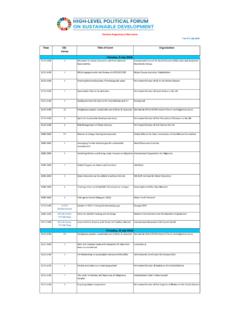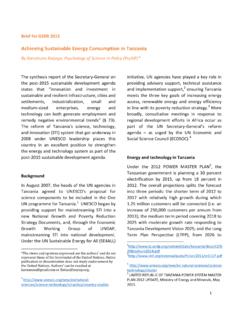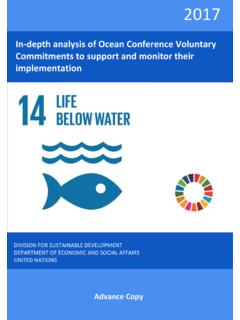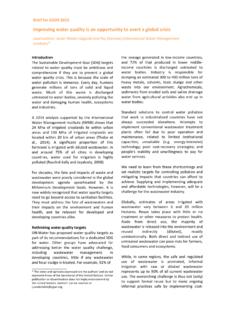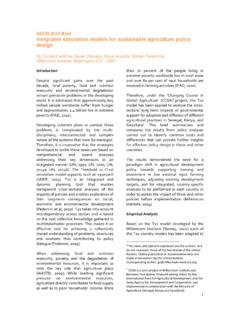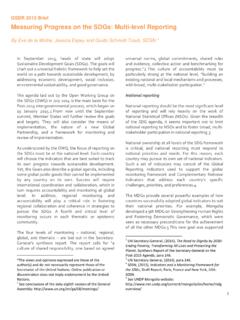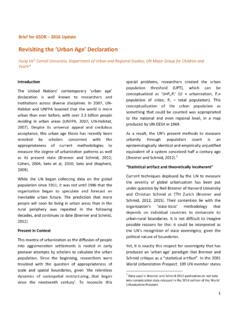Transcription of Guidelines for Reducing Flood Losses - United Nations
1 Guidelines for Reducing Flood LossesISDRI nternational Strategyfor disaster ReductionA contribution to the International Strategy for disaster Reduction (ISDR) United NationsUN Department of Economic and Social Affairs (DESA)Division for Sustainable Inter-Agency Secretariat of the International Strategy for disaster Reduction (UN/ISDR) Oceanic and Atmosphere Administration (USA NOAA) for Reducing Flood LossesUnited NationsAcknowledgementsPaul J. Pilon, Editor and ContributorUN Department of Economic and Social Affairs (DESA)
2 Manuel Dengo, Water, natural Resources and Small Islands Branch,Division for Sustainable DevelopmentMarcia Brewster, Water, natural Resources and Small Islands Branch,Division for Sustainable DevelopmentHenrike Peichert, Water, natural Resources and Small Islands Branch,Division for Sustainable DevelopmentAslam Chaudhry, Water, natural Resources and Small Islands Branch,Division for Sustainable DevelopmentMika Sainio, Division for Sustainable DevelopmentInter-Agency Secretariat of the International Strategy for disaster Reduction (UN/ISDR)John Harding, Scientific & Technical CoordinationNicole Rencoret, Production CoordinationMario Barrantes, Graphic DesignSt phane Kluser, Graphic DesignUN Economic and Social Commission for Asia and the Pacific (UNESCAP)
3 David Jezeph, Water and Mineral Resources Section, Environment and natural Resources Development DivisionUnited States of America, National Oceanic and Atmospheric Administration(USA NOAA)Curt BarrettWorld Meteorological Organization (WMO)Wolfgang Grabs, Water Resources DivisionContributorsDennis A. DavisRobert A. HallidayRichard PaulsonCase StudiesUnited Nations Development Programme, Vietnam, disaster Management UnitRANETZ enaida Delica, Asian disaster Preparedness CenterCover photo: 1998 Flood in Dhaka, Bangladesh.
4 A. Rahim available on-line at contribution to the International Strategy for disaster ReductionThis publication was made possible thanks to the support of the United States of America, National Oceanic andAtmospheric Administration, (USA NOAA) and the Swiss Agency for Development and Cooperation (SDC).iiGuidelines for Reducing Flood LossesForewordThroughout the history of mankind, floods have brought untold wealth and prosperity tocivilizations, and yet at the same time, they have caused tremendous Losses and resulted inuntold suffering for millions of people.
5 Even today, floods lead all natural disasters in thenumber of people affected and in resultant economic Losses , with these numbers rising atalarming rates. In response to the devastation arising from water-related natural disaster , particularlyflooding, a series of three workshops and symposia were held, sponsored by the UnitedStates National Oceanic and Atmospheric Administration (NOAA) and the United NationsDepartment of Economic and Social Affairs. One objective of these events was to createcomprehensive Guidelines that could be used by governments, international organizations,non-governmental organizations and civil society to help avert Losses from flooding .
6 The first session was the Flood Forecasting and disaster Response Workshop. It was held inTegucigalpa, Honduras, from 6-8 April 1999, following the devastation in the regionstemming from Hurricane Mitch. This workshop was followed by an internationalSymposium on Flood Forecasting for the Americas, held in Brasilia, from 15-19 November1999, and it was hosted by the National Institute of Meteorology of Brazil. A rough draft ofthese Guidelines was prepared following this meeting. From 27-31 August 2001, anInternational Symposium on Water-related disaster Reduction and Response was held inBangkok, Thailand, wherein the draft Guidelines were reviewed and new materials weregathered.
7 Materials and ideas from these three meetings have been incorporated into thispublication. It is hoped that these Guidelines can be further improved and that additionalexperiences and concepts can be shared globally in an updated publication is based on the findings of those three sessions and is a contribution to theoverall efforts that are required to help society cope with the forces of nature. Focused effortsare required to reduce the risk of flooding on society. Flood forecasting and warningsystems, data collection systems, Flood plain management practices and land-use planning, aswell as economic and social measures can be adopted within an integrated framework to leadto sustainable solutions.
8 Concerted efforts are required to achieve these solutions, and suchefforts are necessary to stem the rising Losses from water-related disasters. It is truly hopedthat these Guidelines will assist in the planning and implementation of actions leading tomore healthy and resilient Antonio OcampoUnder-Secretary-GeneralUnited Nations Department of Economic and Social AffairsGeneral David Johnson Assistant AdministratorWeather Services USA NOAA National Weather ServiceiiiivGuidelines for Reducing Flood LossesExecutive SummaryFloods have the greatest damage potential ofall natural disasters worldwide and affect thegreatest number of people.
9 On a globalbasis, there is evidence that the number ofpeople affected and economic damagesresulting from flooding are on the rise at analarming rate. Society must move from thecurrent paradigm of post- disaster and efforts must be undertaken tobreak the current event- disaster cycle. Morethan ever, there is the need for decisionmakers to adopt holistic approaches forflood disaster management. Extreme flooding events are not relegated tothe least developed Nations , but can alsodevastate and ravage the most economicallyadvanced and industrialized Nations .
10 In thelast decade there has been catastrophicflooding in Bangladesh, China, India,Germany, Mozambique, Poland, the UnitedStates and elsewhere. When floods occur inless developed Nations , they can effectivelywipe out decades of investments ininfrastructure, seriously cripple economicprosperity, and result in thousands of deathsand epidemics. The majority of the deathsassociated with such disasters can be foundwithin the most vulnerable members ofsociety, namely women and children. Thegreatest tragedy is that most of these deaths,associated post traumatic stresses, and socialand economic hardships can be eitheravoided or dramatically reduced throughpre-, during, and post- disaster investmentsin preparedness activities and associatedinfrastructure, Flood plain policydevelopment, effective watershed land useplanning, Flood forecasting and warningsystems, and response mechanisms.
